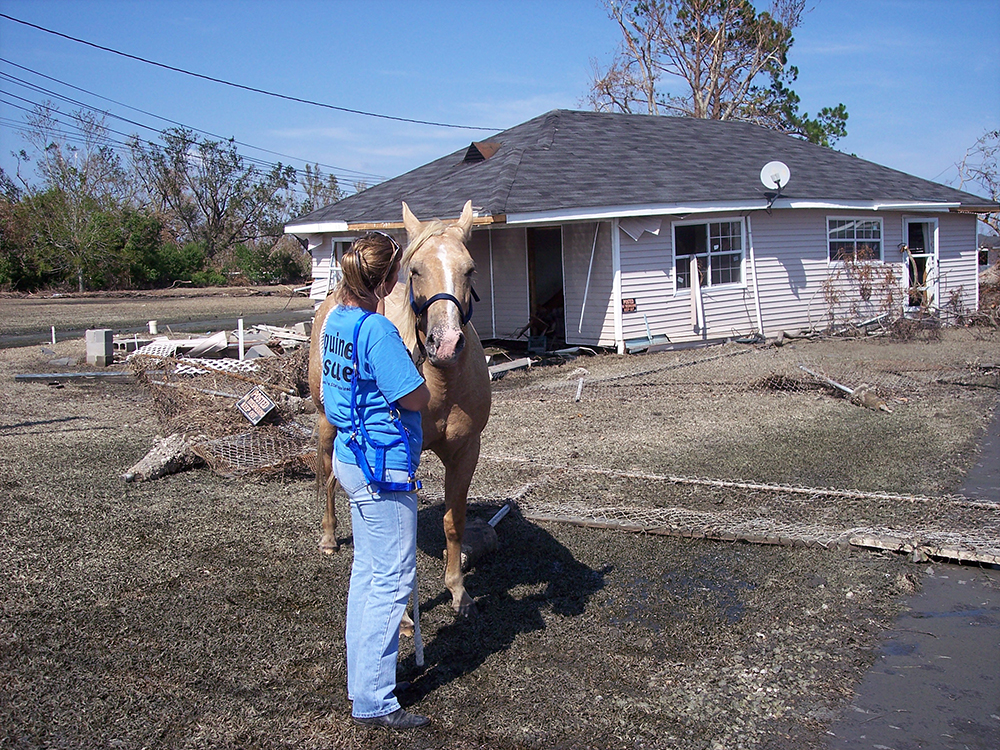Katrina at 20
20 heroic tales of people helping animals
as told to Sandra Sarr, LSU Vet Med strategic communications
Torri Collins, veterinary technician

A volunteer rescuing a horse.
– Photo Credit: Leslie Talley
“The Katrina experience gave me the confidence to handle anything. I had been working at LSU Vet Med for five years when Katrina hit. My first indication that the storm was serious was listening to the radio and callers said there was 10-12 feet of water and they couldn’t pass on roads. LSU Vet Med put out an all-hands-on-deck call to employees. All of our hospital wards were turned into an ER. We opened our homes to complete strangers who came to help. It was organized chaos. We were all triaging 15 patients at a time. We had to calculate medications by hand. Many animals came to us looking like corpses with a heartbeat because they’d been in the flood waters so long. I worked all day at LSU Vet Med, where we saw the sickest, most injured patients, and worked at Lamar Dixon evenings and weekends.
Twenty years later, the images are so vivid in my mind. We walked horses in the scorching heat, and golf carts loaded with Gator Aid would pull up to help keep us hydrated. 18-wheeler trucks dropped off supplies from all over the country. It was desperate times.
I took a horse trailer on a rescue mission into New Orleans with two students and a state veterinarian escort one week after Katrina hit. We drove in on I-10, but finding our way into the city was an issue due to flooded roads. Authorities let us through the barricades but kept rerouting us because of flooded roadways. The scene looked like a war zone, helicopters everywhere dropping baskets, fires, buildings burning, gunshot sounds. Every area we saw was looted, including busted out windows of car dealerships. The stench was awful. Looking down from the overpass, animal bodies floated in 8-10 feet of water. There were people on the overpasses who had been there for a week. We were there to rescue animals. We had to keep stopping because helicopters kept landing on the highways dropping off people from floodwaters and pallets of water onto overpasses. Military, Louisiana National Guard, and police brought the animals to us where our trailer was parked on an overpass. We picked up a few strays on our way out.
The animals we rescued were so scared. Some had been in the flood waters a long time and were soaking wet and foul smelling. Their skin was sloughing off and they were emaciated. Amazingly, none of the dogs, cats, or horses were aggressive—maybe because they were in shock or they were grateful. We treated them all at Lamar Dixon, washed them with Dawn dishwashing soap and applied betadine. Sick ones were transported by trailer to LSU Vet Med.
They were very dark times and very good times too. We were able to get the New Orleans French Quarter mules out to Lamar Dixon. Their caretaker crew stayed with them. New Orleanians can make a good time no matter what. They hooked up the mules, still in good shape because they weren’t in the flood waters, and they gave workers short rides around Lamar Dixon grounds. There was one older, sweet horse who was one of the last for its owner to claim. I decided if no one came, I would take him home.
Katrina taught us to be prepared. Ideally, people need to take their pets with pet records, medications filled for one month’s supply, and health certificates for horses.
It was such rewarding work. We were exhausted but in the best way. It would have been easy to get caught up in the devastation if we didn’t focus on our purpose to help animals. You can’t fix everything, but you can fix what’s in front of you. If you can survive the devastation of Katrina, you can survive anything.”